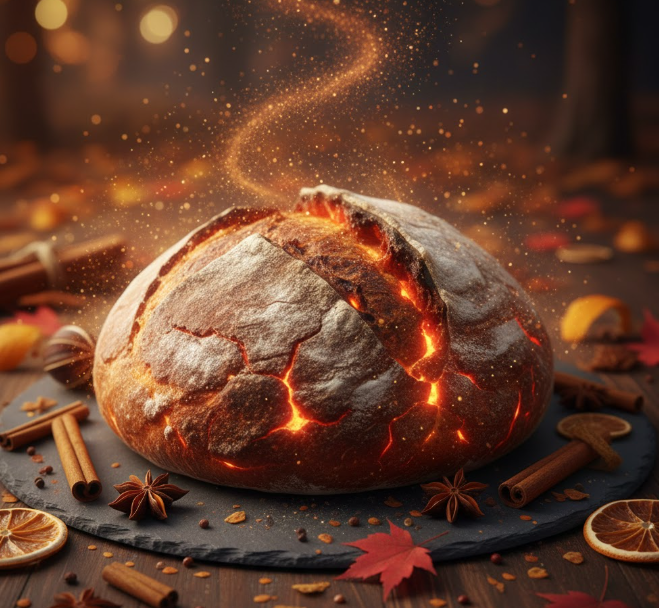Introduction: A Warm Hug in Bread Form
Autumn has a way of wrapping us in warm colors and crisp air, doesn’t it? 🍂 And what better way to celebrate it than with bread that feels like a cozy blanket for your soul? Autumn Ember Bread isn’t just a loaf; it’s an experience. Each slice carries the gentle glow of spices that make your kitchen smell like fall itself. From cinnamon whispers to nutmeg hints, this bread captures the essence of autumn in every bite.
Why Autumn Ember Bread is Special
What sets this bread apart is the balance of warmth and sweetness. Unlike regular breads, this recipe embraces subtle spices rather than overwhelming sugar. It’s a loaf that pairs perfectly with morning coffee, afternoon tea, or even as a snack by the fireplace. Its texture is soft, slightly airy, yet holds enough density to feel satisfying.
Ingredients That Create the Glow
Every ingredient in this bread is chosen carefully for flavor, texture, and aroma. Here’s a simple breakdown:
| Ingredient | Role | Tip |
|---|---|---|
| All-purpose flour | Structure | Sift for smoother texture |
| Brown sugar | Sweetness & color | Light brown for mild caramel flavor |
| Cinnamon | Warmth | Freshly ground for stronger aroma |
| Nutmeg | Depth | Use sparingly; too much can be bitter |
| Ginger | Spicy hint | Optional, but adds zing |
| Butter | Moisture & richness | Melted for soft crumb |
| Milk | Hydration | Slightly warm to activate yeast |
| Eggs | Structure & tenderness | Room temperature works best |
| Yeast | Leavening | Active dry yeast gives best rise |
| Salt | Flavor enhancer | Balances sweetness |
Notice how each ingredient is simple, yet together they create something magical.
The Cozy Spice Blend
The real charm lies in the spice blend. You can mix cinnamon, nutmeg, ginger, and a pinch of allspice for a warm aroma that fills your kitchen. Some people like a dash of clove too—just a whisper, not a shout. 🌰 It’s all about gentle warmth, not overpowering heat.
Step-by-Step Magic
Making this bread isn’t complicated. In fact, the process itself feels like part of the cozy experience.
- Prepare the yeast mixture – Warm milk + sugar + yeast; let it bubble for 5–10 minutes.
- Mix the dry ingredients – Flour, salt, and your cozy spice blend.
- Combine wet and dry – Add eggs and melted butter to the dry mix and knead until smooth.
- First rise – Cover with a cloth and let it double in size (usually 1–2 hours).
- Shape the loaf – Gently deflate, shape, and place in the baking pan.
- Second rise – Let it rise again for 30–45 minutes.
- Bake – At 350°F (175°C) for 35–40 minutes until golden brown.
The smell during baking is incredible—it’s almost like autumn itself sneaked into your kitchen. 🍁
Texture and Flavor Notes
Once baked, the crust has a slight golden crispness, while the inside remains soft and airy. The bread is sweet, but not too sweet. You’ll notice hints of cinnamon and nutmeg, with a touch of warmth from ginger. It’s perfect for spreading butter, drizzling honey, or even pairing with pumpkin butter.
Serving Suggestions
- Breakfast Delight: Toast slices and top with cream cheese or almond butter.
- Afternoon Snack: Pair with chai or coffee for a cozy vibe.
- Dessert Twist: Add a light drizzle of caramel or sprinkle powdered sugar.
- Gift Idea: Wrap in parchment paper and tie with twine—instant homemade gift! 🎁

Tips for the Perfect Autumn Ember Bread
- Use fresh spices; old spices lose aroma.
- Don’t rush the yeast; a slow rise gives better texture.
- Let the bread cool slightly before slicing—this avoids a gummy texture.
- Experiment with add-ins: chopped nuts, dried cranberries, or even chocolate chips for extra comfort.
Healthier Variations
You can make slight adjustments for health-conscious versions:
- Swap half the flour with whole wheat for fiber.
- Reduce sugar slightly and use honey or maple syrup.
- Use plant-based milk and butter substitutes if vegan.
| Variation | Benefit | Flavor Impact |
|---|---|---|
| Whole wheat mix | High fiber | Slightly nuttier taste |
| Honey instead of sugar | Natural sweetness | Subtle floral note |
| Vegan butter & milk | Plant-based | Very similar texture |
| Add pumpkin puree | Moisture & nutrients | Extra autumn flavor |
Why This Bread Feels Like Autumn
There’s something about combining warm spices, soft textures, and golden color that triggers a cozy, nostalgic feeling. It’s the same feeling as walking through falling leaves, sipping something warm, and letting the crisp air fill your lungs. Autumn Ember Bread brings all of that into your home—even if it’s raining outside. 🌧️
Common Mistakes to Avoid
- Not proofing the yeast properly – If yeast doesn’t foam, your bread won’t rise.
- Adding too much flour – Makes it dense; knead until soft and slightly sticky.
- Skipping the second rise – Bread will be flat and compact.
- Overbaking – Keep an eye in the last 5 minutes; crust should be golden, not dark brown.
FAQs
Q: Can I freeze this bread?
A: Yes! Wrap slices in plastic wrap or foil, and freeze for up to 2 months. Toast directly from frozen. ❄️
Q: How long does it stay fresh?
A: Stored in an airtight container at room temperature, it lasts 3–4 days.
Q: Can I make mini loaves?
A: Absolutely! Baking time reduces to 20–25 minutes depending on size.
Q: Can I skip spices?
A: You can, but the warmth and autumn feeling comes from the spices—highly recommended!
Conclusion: Cozy Autumn in Every Bite
Autumn Ember Bread is more than just a recipe; it’s an invitation to slow down, breathe, and savor. Whether you enjoy it alone with tea, or share it with friends and family, it brings warmth, comfort, and that gentle autumn glow into your home. ✨
Baking this bread isn’t just about feeding the body—it’s about feeding the soul. The cozy spice glow, the soft texture, and the nostalgic aroma make it a perfect autumn companion. So grab your mixing bowl, dust off your spices, and let your kitchen fill with the magic of fall. 🍂


